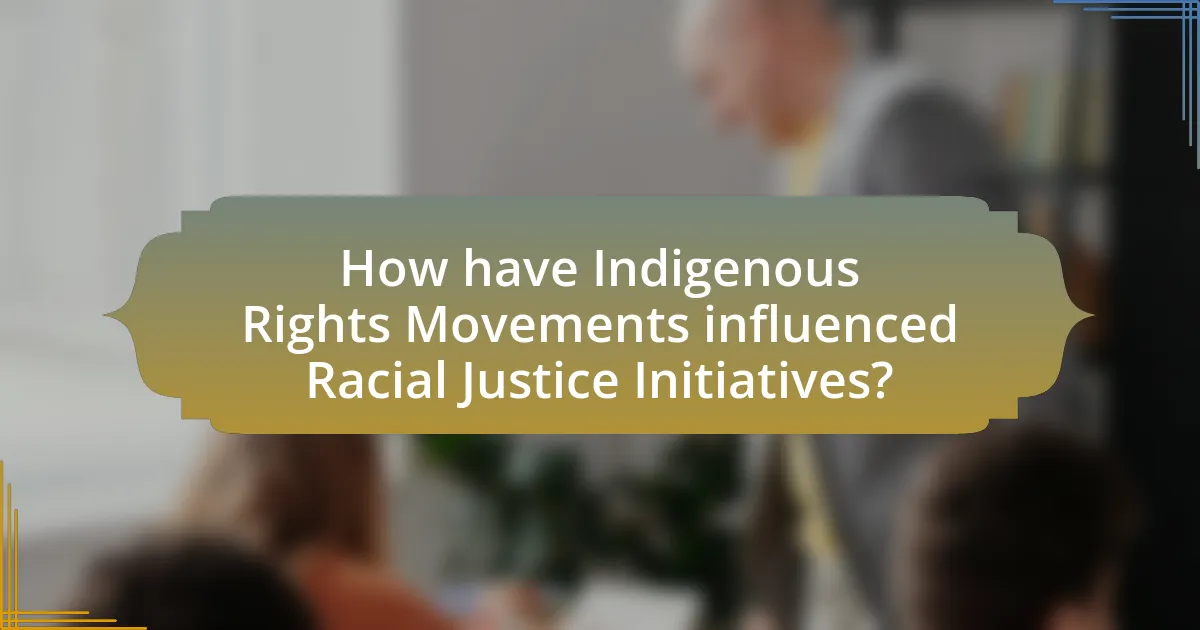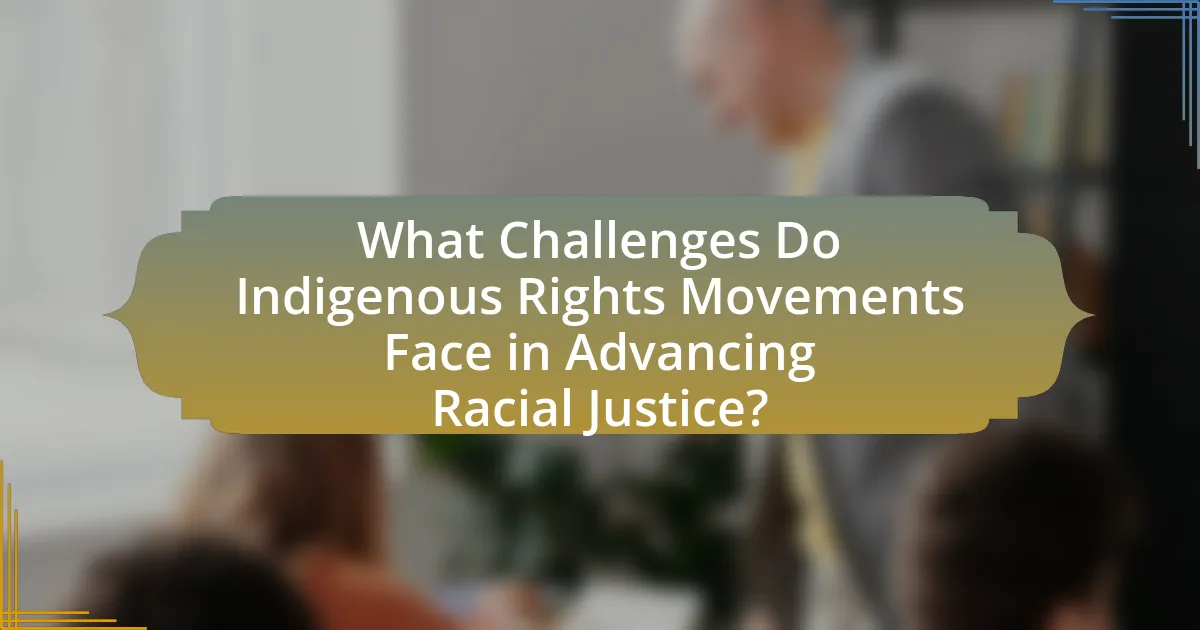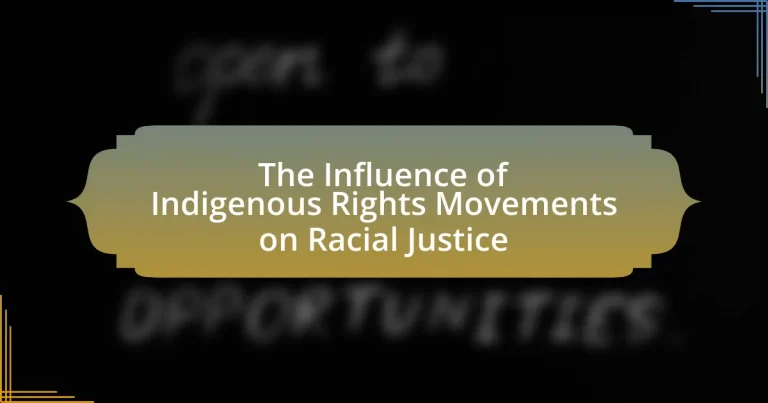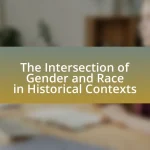Indigenous Rights Movements are organized efforts by Indigenous peoples aimed at advocating for their rights, sovereignty, and cultural preservation, addressing historical injustices and promoting self-determination. This article explores the objectives of these movements, including land rights, cultural preservation, and self-governance, while examining their significance in the broader context of racial justice. It highlights the historical events that have shaped the relationship between Indigenous rights and racial justice, the challenges faced by these movements, and the strategies employed to overcome systemic barriers. Additionally, the article discusses the role of coalitions, the impact of Indigenous activism on legal frameworks, and practical steps individuals and communities can take to support Indigenous rights and foster solidarity.

What are Indigenous Rights Movements and Their Goals?
Indigenous Rights Movements are organized efforts by Indigenous peoples to advocate for their rights, sovereignty, and cultural preservation. These movements aim to address historical injustices, secure land rights, and promote self-determination, often in response to colonization and systemic discrimination. For example, the American Indian Movement, founded in 1968, sought to combat issues such as police brutality and treaty violations, highlighting the need for recognition of Indigenous rights within the legal framework. Additionally, the United Nations Declaration on the Rights of Indigenous Peoples, adopted in 2007, serves as a global standard for the rights of Indigenous communities, reinforcing their goals of autonomy and cultural integrity.
How do Indigenous Rights Movements define their objectives?
Indigenous Rights Movements define their objectives primarily as the recognition and protection of Indigenous peoples’ rights, including land rights, cultural preservation, and self-determination. These movements aim to address historical injustices, such as colonization and systemic discrimination, by advocating for legal recognition of treaties and Indigenous governance systems. For instance, the United Nations Declaration on the Rights of Indigenous Peoples (UNDRIP), adopted in 2007, serves as a framework that supports these objectives by affirming the rights of Indigenous peoples to maintain their cultural identities and manage their lands. This declaration has been instrumental in guiding Indigenous Rights Movements globally, emphasizing the importance of Indigenous voices in decision-making processes that affect their communities.
What specific rights are Indigenous movements advocating for?
Indigenous movements are advocating for specific rights including land rights, self-determination, cultural preservation, and access to natural resources. These rights are essential for Indigenous peoples to maintain their identity, governance, and connection to their ancestral territories. For instance, the United Nations Declaration on the Rights of Indigenous Peoples (UNDRIP) emphasizes the right of Indigenous communities to own, use, develop, and control their lands and resources, which is crucial for their survival and cultural integrity. Additionally, self-determination allows Indigenous groups to govern themselves and make decisions regarding their political, economic, and social development, reinforcing their autonomy and cultural heritage.
How do these objectives vary across different Indigenous communities?
Objectives vary significantly across different Indigenous communities due to diverse cultural, historical, and socio-economic contexts. For instance, some communities prioritize land rights and environmental protection, reflecting their deep connection to ancestral territories, while others may focus on language preservation and cultural revitalization as a means of maintaining identity. Additionally, specific objectives can be influenced by local governance structures, historical treaties, and the presence of external pressures such as resource extraction or urbanization. Research indicates that these variations are essential for understanding the broader impact of Indigenous rights movements on racial justice, as they highlight the unique challenges and aspirations of each community.
Why are Indigenous Rights Movements significant in the context of racial justice?
Indigenous Rights Movements are significant in the context of racial justice because they advocate for the recognition and protection of the rights of Indigenous peoples, addressing historical injustices and systemic discrimination. These movements highlight the intersectionality of race, culture, and land rights, emphasizing that racial justice cannot be achieved without acknowledging and rectifying the unique challenges faced by Indigenous communities. For example, the United Nations Declaration on the Rights of Indigenous Peoples, adopted in 2007, serves as a framework for promoting Indigenous rights globally, reinforcing the importance of self-determination and cultural preservation as essential components of racial justice.
What historical events have shaped the relationship between Indigenous rights and racial justice?
The relationship between Indigenous rights and racial justice has been shaped by several key historical events, including the establishment of treaties, the civil rights movement, and landmark legal cases. The signing of treaties in the 18th and 19th centuries often resulted in the dispossession of Indigenous lands and rights, leading to ongoing struggles for recognition and justice. The civil rights movement of the 1960s, which sought to address racial inequalities, also inspired Indigenous activists to advocate for their rights, culminating in events like the American Indian Movement’s occupation of Alcatraz in 1969. Landmark legal cases, such as the 1978 Supreme Court decision in Oliphant v. Suquamish Indian Tribe, further defined the legal landscape regarding tribal sovereignty and rights. These events collectively illustrate the interconnectedness of Indigenous rights and broader racial justice movements, highlighting the ongoing fight against systemic oppression.
How do Indigenous rights intersect with broader racial justice movements?
Indigenous rights intersect with broader racial justice movements by highlighting systemic inequalities and advocating for the recognition of cultural sovereignty and land rights. These movements emphasize the shared experiences of marginalization faced by Indigenous peoples and other racial minorities, fostering solidarity in the fight against oppression. For instance, the United Nations Declaration on the Rights of Indigenous Peoples (UNDRIP) serves as a framework that aligns Indigenous rights with global human rights standards, reinforcing the idea that racial justice encompasses the rights of all oppressed groups. Additionally, historical events, such as the civil rights movement in the United States, often included Indigenous voices, illustrating the interconnectedness of their struggles for justice and equality.

How have Indigenous Rights Movements influenced Racial Justice Initiatives?
Indigenous Rights Movements have significantly influenced Racial Justice Initiatives by highlighting systemic inequalities and advocating for the recognition of marginalized communities. These movements have brought attention to issues such as land rights, cultural preservation, and sovereignty, which resonate with broader racial justice efforts aimed at dismantling oppressive structures. For instance, the 1960s and 1970s saw the rise of movements like the American Indian Movement, which not only fought for Indigenous rights but also inspired other racial justice movements by emphasizing the interconnectedness of various struggles against oppression. This influence is evident in contemporary initiatives that incorporate Indigenous perspectives, such as the Black Lives Matter movement, which acknowledges the historical and ongoing injustices faced by Indigenous peoples alongside other racial minorities.
What strategies have Indigenous movements employed to impact racial justice?
Indigenous movements have employed strategies such as legal advocacy, grassroots organizing, and coalition-building to impact racial justice. Legal advocacy includes filing lawsuits to protect land rights and challenge discriminatory policies, exemplified by cases like the landmark 1978 Supreme Court decision in Oliphant v. Suquamish Indian Tribe, which highlighted tribal sovereignty. Grassroots organizing mobilizes community members to raise awareness and engage in protests, as seen in the Standing Rock protests against the Dakota Access Pipeline, which drew national attention to Indigenous rights and environmental justice. Coalition-building with other marginalized groups amplifies their voices and fosters solidarity, demonstrated by collaborations with Black Lives Matter and environmental organizations to address systemic racism and environmental degradation. These strategies collectively aim to challenge systemic inequalities and promote racial justice for Indigenous peoples.
How have these strategies evolved over time?
Indigenous rights movements have evolved from localized advocacy for land and cultural preservation to broader coalitions addressing systemic racial injustices. Initially, these movements focused on specific issues such as treaty rights and land claims, exemplified by the American Indian Movement in the 1960s and 1970s, which sought to reclaim sovereignty and address historical grievances. Over time, strategies expanded to include intersectional approaches that connect Indigenous rights with global human rights frameworks, as seen in the adoption of the United Nations Declaration on the Rights of Indigenous Peoples in 2007. This evolution reflects a growing recognition of the interconnectedness of racial justice issues, leading to collaborative efforts with other marginalized groups, thereby amplifying their impact on social justice movements.
What role do coalitions play in amplifying Indigenous voices in racial justice?
Coalitions play a crucial role in amplifying Indigenous voices in racial justice by providing a platform for collaboration, resource sharing, and collective advocacy. These alliances enable Indigenous communities to unite with other marginalized groups, enhancing visibility and influence in social justice movements. For instance, coalitions like the Indigenous Environmental Network have successfully mobilized support for Indigenous rights in environmental justice campaigns, demonstrating the effectiveness of collective action. Additionally, research shows that coalitions can increase the capacity for grassroots organizing, leading to more impactful policy changes that address systemic inequalities faced by Indigenous populations.
What successes have Indigenous Rights Movements achieved in promoting racial justice?
Indigenous Rights Movements have achieved significant successes in promoting racial justice by advocating for legal recognition, land rights, and cultural preservation. For instance, the United Nations Declaration on the Rights of Indigenous Peoples, adopted in 2007, has provided a framework for Indigenous communities to assert their rights and seek justice against historical injustices. Additionally, landmark legal cases, such as the 2014 Supreme Court of Canada ruling in Tsilhqot’in Nation v. British Columbia, recognized Indigenous land rights, affirming the importance of Indigenous sovereignty and self-determination. These movements have also raised awareness about systemic racism and discrimination faced by Indigenous peoples, leading to policy changes and increased representation in political and social spheres.
Which landmark cases or policies have been influenced by Indigenous activism?
Landmark cases and policies influenced by Indigenous activism include the 1973 United States Supreme Court case of United States v. Wheeler, which affirmed tribal sovereignty, and the 1982 Canadian Constitution Act, which recognized and affirmed the rights of Indigenous peoples. These cases demonstrate the significant impact of Indigenous activism on legal frameworks, leading to greater recognition of Indigenous rights and self-determination. The activism surrounding these cases has been pivotal in shaping policies that address historical injustices and promote racial justice for Indigenous communities.
How have these successes changed public perception of racial justice issues?
Successes in Indigenous rights movements have significantly shifted public perception of racial justice issues by highlighting systemic inequalities and fostering greater awareness of marginalized communities. For instance, the recognition of land rights and cultural preservation has led to increased empathy and support for broader racial justice initiatives, as seen in the heightened visibility of movements like Black Lives Matter, which often draw parallels to Indigenous struggles. Research indicates that public support for racial justice has grown, with a 2020 Pew Research Center survey showing that 76% of Americans believe that the country needs to continue making changes to give Black people equal rights, reflecting a broader understanding of interconnected racial issues.

What Challenges Do Indigenous Rights Movements Face in Advancing Racial Justice?
Indigenous rights movements face significant challenges in advancing racial justice, primarily due to systemic discrimination, lack of political representation, and cultural erasure. Systemic discrimination manifests in policies that disproportionately affect Indigenous communities, such as land dispossession and inadequate access to resources. For instance, Indigenous peoples in Canada and the United States experience higher rates of poverty and unemployment compared to non-Indigenous populations, which hinders their ability to advocate effectively for racial justice.
Additionally, the lack of political representation in legislative bodies limits Indigenous voices in decision-making processes, resulting in policies that do not reflect their needs or rights. According to a 2019 report by the United Nations, Indigenous peoples are often excluded from political processes, which perpetuates their marginalization. Cultural erasure, driven by historical assimilation policies and ongoing stereotypes, further complicates the efforts of Indigenous rights movements to assert their identity and rights within the broader racial justice framework.
These challenges collectively impede the progress of Indigenous rights movements in achieving racial justice, as they struggle against entrenched societal and institutional barriers.
What systemic barriers hinder the progress of Indigenous rights and racial justice?
Systemic barriers that hinder the progress of Indigenous rights and racial justice include institutional racism, lack of political representation, and socioeconomic disparities. Institutional racism manifests in policies and practices that disproportionately affect Indigenous communities, such as discriminatory law enforcement and inadequate access to justice. The lack of political representation limits Indigenous voices in decision-making processes, resulting in policies that do not address their needs. Socioeconomic disparities, evidenced by higher rates of poverty and unemployment among Indigenous populations compared to non-Indigenous groups, further exacerbate inequalities and hinder progress toward racial justice. These barriers collectively impede the advancement of Indigenous rights and the broader movement for racial justice.
How do socio-economic factors impact the effectiveness of Indigenous movements?
Socio-economic factors significantly impact the effectiveness of Indigenous movements by influencing their organizational capacity, resource availability, and public support. For instance, lower socio-economic status often limits access to education and political engagement, which can hinder the ability of Indigenous groups to mobilize effectively. Research indicates that Indigenous communities with higher socio-economic status tend to have better access to legal resources and advocacy networks, enhancing their ability to challenge injustices and negotiate with governments. Additionally, socio-economic disparities can affect the visibility of Indigenous issues in broader societal contexts, as movements from economically disadvantaged communities may struggle to gain media attention and public sympathy, thereby reducing their overall impact.
What role does government policy play in these challenges?
Government policy significantly shapes the challenges faced by Indigenous rights movements in the context of racial justice. Policies can either support or hinder the recognition of Indigenous rights, impacting their ability to advocate for justice and equality. For instance, the implementation of land rights legislation can empower Indigenous communities, while the absence of such policies can perpetuate systemic inequalities. Historical examples include the Indian Self-Determination and Education Assistance Act of 1975 in the United States, which aimed to enhance Indigenous governance and education, illustrating how supportive policies can facilitate progress in racial justice. Conversely, policies that ignore or undermine Indigenous sovereignty contribute to ongoing challenges, highlighting the critical role of government action in addressing these issues.
How can Indigenous Rights Movements overcome these challenges?
Indigenous Rights Movements can overcome challenges by fostering alliances with other social justice organizations to amplify their voices and share resources. Collaborating with groups that have similar goals can enhance visibility and create a united front against systemic injustices. For instance, the Standing Rock protests against the Dakota Access Pipeline in 2016 showcased how Indigenous activists partnered with environmentalists and civil rights organizations, drawing international attention and support. This coalition-building approach not only strengthens advocacy efforts but also helps to educate broader audiences about Indigenous issues, thereby increasing public support and political pressure for change.
What strategies have proven effective in addressing systemic barriers?
Effective strategies for addressing systemic barriers include advocacy for policy reform, community mobilization, and education initiatives. Advocacy for policy reform has led to significant changes in legislation that promote equity, such as the Indian Self-Determination and Education Assistance Act, which empowers Indigenous communities. Community mobilization fosters solidarity and collective action, exemplified by movements like Idle No More, which raised awareness about Indigenous rights and environmental issues. Education initiatives, such as culturally relevant curricula, have been shown to improve understanding and respect for Indigenous histories and rights, thereby reducing systemic discrimination. These strategies collectively contribute to dismantling systemic barriers and advancing racial justice.
How can allyship enhance the efforts of Indigenous movements in racial justice?
Allyship can enhance the efforts of Indigenous movements in racial justice by amplifying their voices and providing critical support in advocacy efforts. When allies actively listen to Indigenous perspectives and share their platforms, they help to raise awareness about systemic injustices faced by Indigenous communities. For instance, during the Standing Rock protests against the Dakota Access Pipeline, non-Indigenous allies played a significant role in drawing national and international attention to the issues of land rights and environmental justice, which are central to Indigenous struggles. This collaboration not only strengthens the movement but also fosters solidarity, encouraging broader societal engagement in racial justice initiatives.
What practical steps can individuals take to support Indigenous Rights Movements and racial justice?
Individuals can support Indigenous Rights Movements and racial justice by actively engaging in advocacy, education, and community support. Advocacy can include participating in protests, signing petitions, and contacting elected officials to express support for policies that protect Indigenous rights. Education involves learning about Indigenous histories, cultures, and current issues, which can be achieved through reading books, attending workshops, or following Indigenous voices on social media. Community support can manifest in donating to Indigenous-led organizations, volunteering time, or amplifying Indigenous perspectives in discussions about racial justice. These actions contribute to raising awareness and fostering solidarity with Indigenous communities, which is essential for advancing racial justice.
How can education and awareness contribute to the cause?
Education and awareness can significantly contribute to the cause of Indigenous rights movements by fostering understanding and empathy towards the challenges faced by Indigenous communities. Increased education about historical injustices, such as land dispossession and cultural erasure, equips individuals with the knowledge necessary to advocate for racial justice. For instance, studies show that educational programs focused on Indigenous history and rights lead to greater support for policies that promote equity and justice, as evidenced by the 2019 report from the National Congress of American Indians, which highlights that informed citizens are more likely to engage in advocacy efforts. Thus, education and awareness serve as foundational tools in mobilizing support for Indigenous rights and advancing racial justice initiatives.
What actions can communities take to foster solidarity with Indigenous movements?
Communities can foster solidarity with Indigenous movements by actively supporting Indigenous-led initiatives and advocating for their rights. This includes participating in campaigns that promote land sovereignty, recognizing and respecting treaties, and amplifying Indigenous voices in decision-making processes. For instance, the United Nations Declaration on the Rights of Indigenous Peoples emphasizes the importance of consultation and cooperation with Indigenous peoples, which communities can uphold by engaging in meaningful dialogue and collaboration. Additionally, communities can educate themselves and others about Indigenous histories and contemporary issues, thereby dismantling stereotypes and fostering a deeper understanding of the struggles faced by Indigenous peoples.


